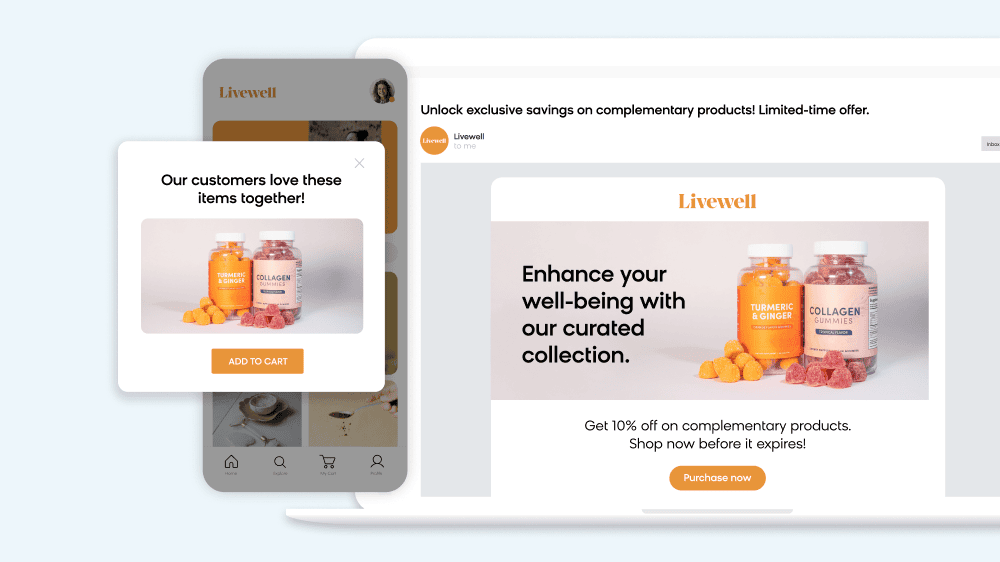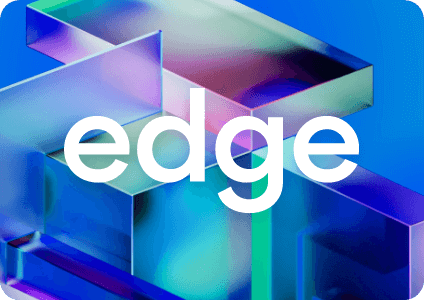Dynamic email content represents a fundamental shift from static messaging to adaptive, modular blocks that change based on individual user behavior, real-time context, and predictive intent signals. Unlike traditional personalization, dynamic content uses artificial intelligence to make content decisions at the moment of email open, not at send time.
Bloomreach Engagement powers this next generation of cross-channel, AI-driven personalization that evolves automatically without manual intervention. Thanks to Loomi AI, the platform treats email as one dimension of broader autonomous personalization that spans web experiences, SMS campaigns, and advertising touchpoints.
Discover how dynamic email content transforms individual campaigns into comprehensive, conversation-driven customer journeys that anticipate user needs and deliver big results.
The Limitations of Traditional Email Personalization
Traditional email personalization approaches suffer from three fundamental limitations that prevent meaningful customer engagement and revenue growth:
Static Segmentation Misses Real-Time Context
Demographic data and historical behavior patterns become outdated quickly, missing the real-time context that influences purchasing decisions. Batch processing cycles mean content decisions are made hours or days before customers actually open emails, rendering personalization attempts irrelevant when customers’ needs have already shifted.
Fragmented Technology Creates Operational Delays
When customer data, content management, and campaign execution exist in separate systems, marketers can’t respond quickly to changing customer needs or behavior patterns. The result is generic messaging disguised as personalization, creating disconnected insights that prevent meaningful engagement.
Rule-Based Systems Lack True Adaptability
Most platforms claiming “dynamic” capabilities simply offer predetermined content swaps using basic criteria. These systems may change product recommendations based on browsing history, but the underlying content strategy remains static and doesn’t adapt to evolving customer intent or market conditions.
Bloomreach’s approach to AI-driven personalization addresses these limitations by unifying customer data, content decisions, and campaign execution in real time. The platform moves beyond demographic assumptions to focus on predictive intent signals that indicate what customers are likely to need or want next.

The Evolution From Reactive to Autonomous Email Marketing
Dynamic email content evolution follows a clear progression from reactive batch processing to proactive, intelligent orchestration that transforms how brands engage with customers across their entire journey.
Past approaches relied on batch emails using static subscriber lists, with minimal segmentation based on demographic data. Marketers created single messages broadcast to entire databases, achieving low engagement rates and high unsubscribe rates.
Present capabilities include rule-based dynamic blocks that adjust content based on predetermined criteria, but these systems remain delayed and reactive. Content decisions are still made at send time using historical data rather than current intent signals, limiting relevance and effectiveness.
Future opportunities center on AI-powered, real-time orchestration that extends beyond email to encompass comprehensive customer journey management.
Bloomreach enables you to reach this future state through several advanced capabilities:
- Real-time decisioning: Content decisions can happen at email open rather than send time, ensuring maximum relevance based on the customer’s current context and recent behavior patterns
- Autonomous optimization: The AI system automatically selects optimal channels, timing, and messaging for each individual customer
- Multi-channel coordination: Integration of email with SMS, web experiences, and advertising in one unified system prevents message conflicts and maximizes touchpoint effectiveness
- Individualized sequences: Each customer receives unique email sequences driven by real-time predictive profiles that evolve based on ongoing behavior and engagement patterns

This approach eliminates the need for static segments or predetermined campaign sequences, allowing for truly individualized customer experiences that drive measurable business results.
Dynamic vs. Autonomous Email: Understanding the Difference
Understanding the difference between traditional “dynamic” email and truly autonomous email systems requires examining specific capabilities that impact customer engagement and business outcomes:
| Traditional “Dynamic” Email | Bloomreach Autonomous Email |
|---|---|
| Rules and static variants | Real-time AI decisioning |
| Static segments | Evolving intent signals |
| Manual A/B testing | Continuous optimization (e.g., contextual personalization) |
| Creative-only personalization | Holistic — format, message, product, timing |
| Email only | Omnichannel orchestration (web, SMS, ads, app, and more) |
Traditional systems use predetermined rules to swap content blocks based on subscriber attributes or past behavior. These systems make content decisions at campaign creation time, using static data that may not reflect current customer intent or changing market conditions.
Autonomous platforms make content decisions in real time using artificial intelligence algorithms that consider current behavior, predictive intent signals, and cross-channel interactions. The AI adapts continuously based on customer responses and changing market conditions without requiring manual intervention.
How TeamSport Boosted Revenue by 135% Through Dynamic Emails
TeamSport, a leading entertainment venue operator, was lacking the up-to-date data it needed to create personalized campaigns. However, thanks to Bloomreach Engagement and its customer data engine, the brand was able to unify all its data and get a complete view of each customer.
Thanks to the insights and the AI-driven platform, TeamSport was able to go from two monthly emails and 10 triggered campaigns a month to over 50 communications. These campaigns ranged from straightforward abandoned cart emails to more complex voucher campaigns that tapped into Bloomreach’s dynamic personalization capabilities.
As a result, TeamSport was able to drive a 135% increase in its last-click attribution from email campaigns, showing how big an impact email personalization can drive.

Implementation Guide: Launching Dynamic Email Content
Implementing advanced dynamic email content requires systematic progression through data integration, audience development, content optimization, and performance measurement phases:
Phase 1: Building the Foundation
Centralize your data by integrating customer relationship management systems, behavioral tracking data, transactional records, and engagement metrics into a unified customer data platform. This foundation enables real-time personalization decisions based on comprehensive customer context rather than limited demographic or historical information.
Define segments using real-time intent signals rather than static demographic categories or past purchase behavior. Intent-driven segmentation considers current browsing patterns, engagement timing, content preferences, and cross-channel interactions to create dynamic audience groups that evolve based on changing customer needs.
Phase 2: AI-Powered Optimization
Use Loomi AI for send-time, content, and channel optimization to automate complex decision-making processes that would otherwise require extensive manual testing and analysis. The AI system continuously optimizes campaign performance across multiple variables simultaneously while providing strategic insights for future campaign development.
Adopt AI-powered templates for agility and scale by implementing dynamic content frameworks that adapt automatically to individual customer profiles and behavior patterns. These templates eliminate the need for manual campaign creation while ensuring personalization remains relevant and effective across diverse customer segments.
Phase 3: Continuous Improvement
Test and iterate with AI-led variant optimization that goes beyond traditional A/B testing to implement sophisticated multivariate algorithms. The AI automatically identifies the best variants on an individual basis to create more personalized experiences at scale.
Ultimately, you’ll want to begin with basic data integration and segmentation improvements before advancing to complex AI-driven optimization and cross-channel orchestration.
Our email personalization best practices guide provides detailed tactical advice for executing each phase of the activation process while avoiding common pitfalls that can delay results or create technical complications.

The Future of Customer-Centric Email Marketing
Dynamic email content represents a fundamental evolution from campaign-focused marketing to conversation-driven customer relationships. The technology enables marketers to move beyond demographic assumptions and historical behavior patterns toward intelligent, predictive personalization that adapts continuously to changing customer needs and market conditions.
Marketers who embrace autonomous email marketing capabilities position themselves to deliver superior customer experiences while improving operational efficiency and business results. The technology eliminates manual optimization tasks while providing strategic insights that inform broader marketing strategy development, allowing teams to scale personalization efforts that were previously resource-intensive.
Ready to transform your email marketing strategy? Explore Bloomreach’s email personalization capabilities to see how you can drive meaningful customer relationships and measurable business growth today.
Frequently Asked Questions About Dynamic Email Content
What is dynamic email content?
Dynamic email content refers to email elements that customize automatically at the moment of open using real-time customer data, including browsing habits, purchase history, engagement patterns, and predictive intent signals. Unlike static personalization that makes content decisions at send time, dynamic content adapts based on current customer context and behavior.
How does AI impact email personalization?
Artificial intelligence transforms email personalization by predicting individual customer preferences and automatically adapting content, timing, and channel selection accordingly. AI systems analyze comprehensive customer data to identify patterns and trends that humans cannot process efficiently, enabling personalization at scale while continuously optimizing performance based on engagement results.
Why is Bloomreach different from other email providers?
Bloomreach uniquely integrates customer data unification, cross-channel orchestration, and AI-driven decision-making into one cohesive platform. While other providers focus on email as an isolated channel, Bloomreach coordinates messaging across web, SMS, advertising, email, and more to create comprehensive customer experiences that improve engagement and conversion rates.
Will dynamic content improve ROI?
Yes, dynamic content significantly improves return on investment when implemented through intelligent platforms that optimize for business outcomes rather than engagement metrics.
How quickly can dynamic content implementation show results?
Results typically appear within the first few months of proper implementation, with performance improvements accelerating as AI algorithms gather more customer interaction data. Initial improvements often focus on engagement metrics like open and click rates, while conversion and revenue improvements develop as the AI optimizes for content selection and timing strategies.
What data is required for effective dynamic content?
Effective dynamic content requires customer behavioral data, transaction history, engagement patterns, and preferably real-time website interaction data. Email engagement metrics, purchase frequency, product preferences, and cross-channel interaction patterns provide additional context that improves personalization accuracy and relevance.













